Kalamkari sarees are globally renowned for their elegance and rich heritage that dates back to the medieval times. Kalamkari is a Persian word that is a combination of two words. ‘Kalam’ which means pen and ‘kari’ which means artwork or craftsmanship. This literally translates to mean drawing with a pen. So Kalamkari is hand painted or block printed work on cotton textile done in Andhra Pradesh and Telangana but originally from the Mughal period. The Kalamkari art dates back to 3000 B.C. in Iran during the Sasani era.
Historical background
In ancient times, musicians, painters, and folk singers narrated their Hindu mythology tales by painting on a large canvas using organic colours from plants. However, during the Mughal Empire, skilled artisans known as the qalamkars in Golconda and Coromandel practiced this beautiful art. This is where the name kalamkari evolved from.
During the middle Ages, the kalamkari art is incorrectly used to mean weaving cotton fabric with vegetable dyes by block printing or free-hand painting. This art form became popular during the rule of the Golconda Sultanate of Hyderabad. It was mainly practiced in Machilipatnam in Krishna Andhra Pradesh. Later Kalamkari art started to decline but was revived in the 18th Century by the British who admired and loved this traditional art form on their clothes.
With the advent of technology, the kalamkari art has been digitalized to preserve this ethnic fashion. New technology has now replaced the time-consuming handwork done by weavers.
Colours
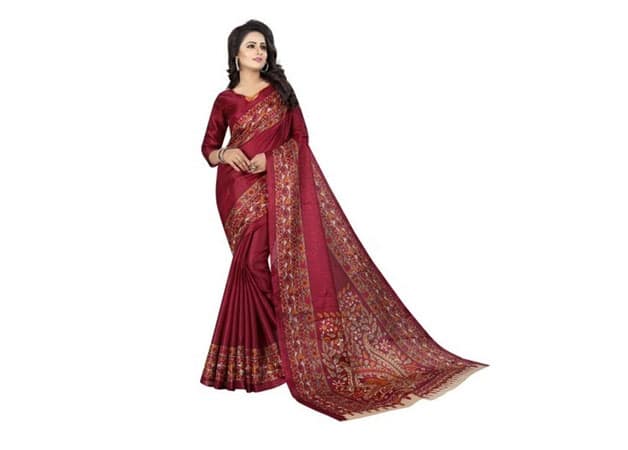
Natural colours are used in the art of Kalamkari. The dyes are got from vegetables, plants, roots, cow dung seeds, crushed flowers, seeds and mineral salts of tin, copper, iron, and alum. Most of the Kalamkari fabric colours are green, maroon, rust, black, mustard, and indigo. Myrobolan is a fixing agent that is used to fix the colour or dye on the fabric while treating the fabric. Alum is a solution used to keep the stability of the colour on the Kalamkari saree. Women figures are mostly painted in yellow, demons in green and red, and Gods in blue colours with a red background and lotus motifs.
Different themes and motifs
There are different themes that are depicted in Kalamkari sarees. The Gujarat Kalamkari sarees have popular motifs of Hindu epics like Ramayana and recently the Buddhist art forms, Lord Krishna, and Lord Ganesha. The Karrupur Kalamkari sarees are styled sarees worn by the royal families during the Raja Shivaji period woven in gold brocade works. The Srikalahasti sarees have been drawn religious stories and temple motifs while the Machilipatnam sarees have inspired Persian Dutch and Persian motifs during the British rule.
Main types of the Kalamkari saree fabric
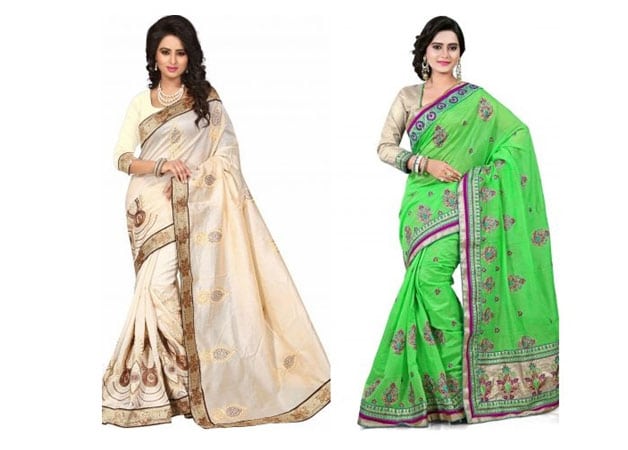
The Kalamkari style of drawing has two distinct styles; the Srikalahasti and the Machilipatnam.
Kalamkari sarees woven using the Srikalahasti style are wholly hand woven. This style is inspired by religion where motifs of chariots banners, Hindu deities from Hindu epics like Ramayana, scrolls and temple hangings can be seen on the fabric. The intricate monochrome drawings drawn using a pen or a sharpened bamboo are very common on these sarees. No dyes were used in this style of drawing.
The Kalamkari sarees woven using the Machilipatnam style were made using natural dyes from vegetables, plants, and flowers. Wooden blocks were used to apply the colours. This style of drawing was inspired by Persian art and influenced by the Mughal Empire and Golconda Sultanate. This style was known as Pedana craft and it was practiced near Machilipatnam in Krishna Andhra Pradesh. This style produces stylish sarees with an organic flavour.
The technique used to make Kalamkari fabric
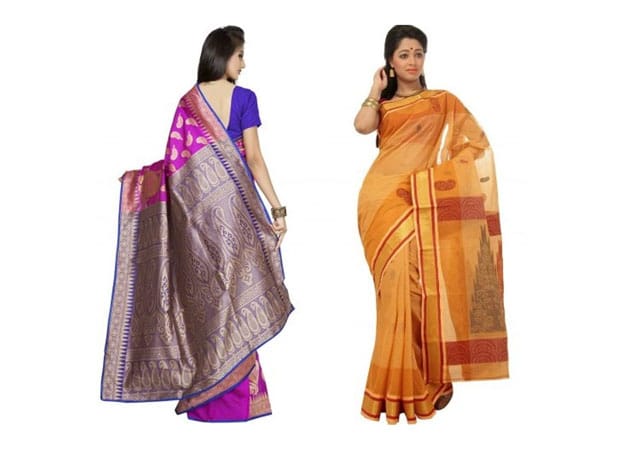
Making this beautiful fabric is a long, tedious, and time-consuming process that takes 23 steps. It requires precision and a keen eye to details.
The fabric is soaked for an hour in resin and cow milk to give that glossy look on a saree. The cotton material is then soaked in cow dung and bleach for several hours to attain the off-white colour. The fabric is then sun-dried and soaked again in buffalo milk and myrobalan fruit dust for a few minutes to prevent smudging of colours when dyeing using organic dyes.
The fabric is sun-dried then washed with running water to remove the buffalo milk odour. Washing is done 20 times and sun-dried to get desired results. The brown, black, violet and red portions of the design are outlined using a mordant and the fabric soaked in alizarin solution. The fabric is then covered with wax except for the parts to be dyed blue. It’s then dipped in indigo blue dye. Later the wax is removed and the remaining parts are hand painted just like Indonesian batik.
To paint different designs on the fabric craftsmen use a date palm stick or a sharp pointed bamboo pen. A cotton cloth is tied at the sharp tip of the pen using a thread then the pen is soaked in sugar and palm jaggery and water then it’s applied on the fabric. Vegetable dye is then later applied to fill the colours in the drawings. Wooden stamps are used in Iran to print the fabric.
Unique features
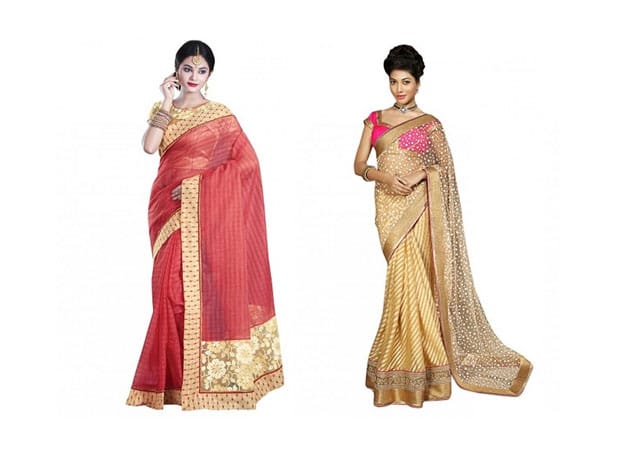
- The elegance and style of traditional Kalamkari sarees combined with the rich craftsmanship woven on these sarees have earned them global recognition and admiration.
- With the changing times, the Kalamkari sarees are now available in crepe, chiffon, georgette, brocade, cotton-silk, chanderi, and other materials you can find at stylecaret online stores.
- The Kalamkari saree material can shrink easily hence dry cleaning is recommended.
- Kalamkari sarees now come in many unique colours and prints that are both traditional and contemporary to accommodate all styles and tastes.
- Another very unique feature of the Kalamkari saree is that the colours don’t fade with many washes because natural dyes and colours are used.
- This saree has a beautiful blend of heritage and elegance that is easily incorporated in its latest trending designs.
Conclusion
The rich look of the Kalamkari sarees fabric sets it apart from other sarees. Even though it’s a traditional saree, it has been embraced by the modern fashion industry.



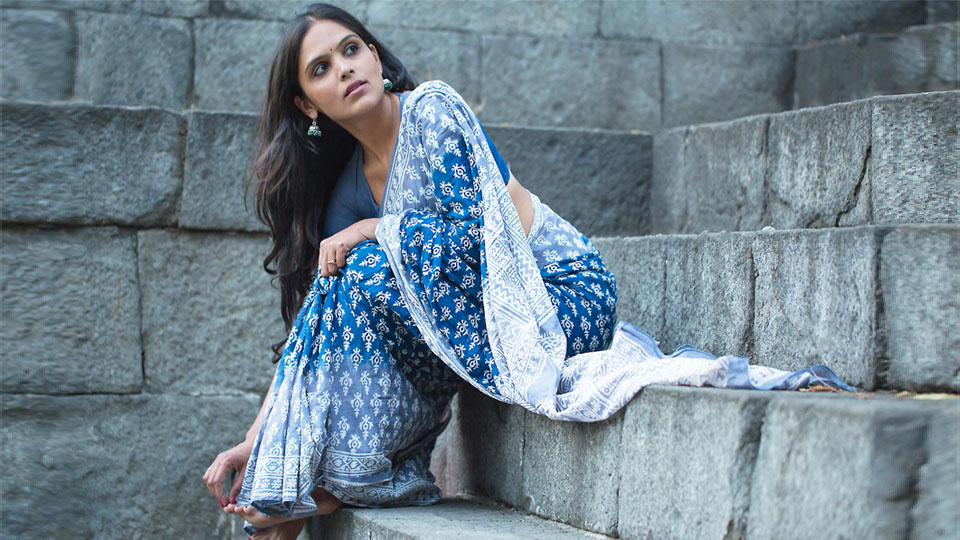




Recent Comments